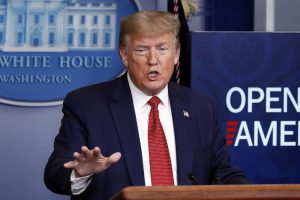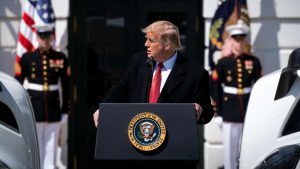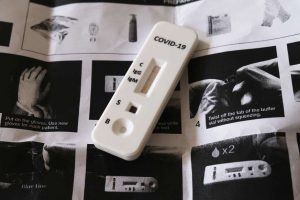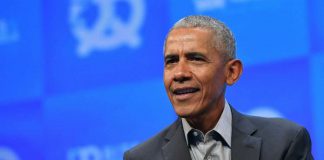APRIL 17, 2020

President Donald Trump speaks about the coronavirus in the James Brady Press Briefing Room of the White House, Thursday, April 16, 2020, in Washington. (AP Photo/Alex Brandon)
WASHINGTON, D.C. – President Trump told the nation’s governors on Thursday that they could begin reopening businesses, restaurants and other elements of daily life by May 1 or earlier if they wanted to, but abandoned his threat to use what he had claimed was his absolute authority to impose his will on them.
On a day when the nation’s death toll from the coronavirus increased by more than 2,000 for a total over 30,000, the president released a set of nonbinding guidelines that envisioned a slow return to work and school over weeks or months. Based on each state’s conditions, the guidelines in effect guarantee that any restoration of American society will take place on a patchwork basis rather than on a one-size-fits-all prescription from Washington that some of the governors had feared in recent days.
“We are not opening all at once, but one careful step at a time,” Mr. Trump told reporters during a briefing at the White House.
Mr. Trump essentially gave cover to mainly Republican governors of states in the South and West that have not been as hard hit by the pandemic to begin reopening sooner. The president, who has previously said that as many as 29 states could reopen soon, told governors on a conference call before his announcement that some of them were “in very, very good shape” and could move further and faster to resuming economic and social activities.
If they follow the guidelines, New York and other states in the Northeast, as well as states in the Midwest and West, that have seen large outbreaks would remain shuttered for weeks until new cases of the virus and death tolls fall and hospital capacity is restored.
The guidelines envision proceeding without the comprehensive testing program that many public health experts have sought and opened the president to criticism that in his eagerness to start rebuilding a cratered economy, he may have encouraged some states to move too quickly and leave themselves exposed to a second wave of the coronavirus.
Speaker Nancy Pelosi dismissed the guidelines even as she pushed for more testing. “The White House’s vague and inconsistent document does nothing to make up for the president’s failure to listen to the scientists and produce and distribute national rapid testing,” she said in a statement.
The 18-page document released by the White House provided mostly general guidance and did not confront some difficult questions, including how to finance the billions of dollars necessary for expanded testing; whether travel should be restricted between states; when the ban on international travel from Europe and elsewhere would be lifted; and how the states should deal with future shortages of protective equipment if the virus resurged in the fall.
The guidelines assume the ability to quickly contain future outbreaks by quarantining sick people and their contacts, but they provide no specifics about how strained public health systems around the country will achieve that goal.
“You’re going to call your own shots,” Mr. Trump told the governors, according to an audio recording provided to The New York Times. “You’re going to be calling the shots. We’ll be standing right alongside of you, and we’re going to get our country open and get it working. People want to get working.”
At the evening briefing, the president conceded that the choice of how and when to reopen the country would not be his. “If they need to remain closed,” he said, “we will allow them to do that.”
Mr. Trump’s choice of words amounted to a significant reversal only three days after he insisted that “the president of the United States calls the shots” and that he had the “total” authority to decide how and when the country would end widespread lockdowns. Several governors rebelled at the notion, defying Mr. Trump’s assertion of unilateral power and declaring that they would come to their own conclusions.

President Trump said on Thursday that states could begin resuming public activities before May 1 if they wanted to. The president said a little more than three weeks ago that he wanted to reopen the country by Easter, April 12, then changed the date to May 1 before declaring that when to do it would be “the biggest decision I’ve ever had to make.” – Doug Mills/NY Times
He has repeatedly lurched from one position to another as his administration has struggled to confront what he calls an “invisible enemy.”
For weeks, he played down the threat from the coronavirus, predicting it would “miraculously” disappear in warm weather. As the number of cases overwhelmed some hospitals, Mr. Trump blamed governors for failing to prepare, even as he claimed credit for federal help that was slow to arrive.
The federal guidelines, which recommend phased reopenings depending on case levels and hospital capacity, came as governors were already setting their own courses.
Gov. Andrew M. Cuomo of New York announced that the state’s sweeping shutdown would last until at least May 15, while Gov. Mike DeWine of Ohio said he planned to begin lifting restrictions on public activities starting May 1. Gov. Tony Evers of Wisconsin said residents must stay at home until May 26, and in Missouri, Kansas City and St. Louis County both extended similar orders.
A bipartisan group of governors from the Midwest that included Mr. DeWine and Mr. Evers announced the formation of a regional coalition to weigh next steps, which the governors said would be “fact-based” and “data-driven.” Other coalition members include Gov. J.B. Pritzker of Illinois, Gov. Gretchen Whitmer of Michigan, Gov. Tim Walz of Minnesota, Gov. Eric Holcomb of Indiana and Gov. Andy Beshear of Kentucky.
States elsewhere in the country with fewer cases and smaller, more rural and more distant populations may take their cue from Mr. Trump and begin moving to lift restrictions.
The fitful movement toward reopening came as another 5.2 million Americans filed for unemployment benefits, bringing the total number of people put out of work in the past four weeks to a staggering 22 million. Facing the worst economic crisis since the Great Depression only six months before an election, Mr. Trump has felt enormous pressure to get business restarted and put Americans back to work.
A federal loan program intended to help small businesses keep workers on their payrolls has proved woefully insufficient. The administration said Thursday that the Paycheck Protection Program had run out of money, leaving millions of businesses unable to apply for the loans while Congress struggled to reach a deal to replenish the funds.

A COVID-19 IgG and IgM Rapid Test Cassette is displayed on April 16, in New York City. The take home test says they can tell a person if they have Coronavirus antibodies in their system, thus indicating that they have had the virus.
The guidelines released by the president — titled, “Opening Up America Again” — urge states not to lift stay-at-home or travel restrictions until they reach a 14-day period in which the number of coronavirus cases is steadily declining, hospitals are not overwhelmed and robust testing is in place for health care workers and others.
“The dominating drive of this was to make sure this is done in the safest way possible,” said Dr. Anthony S. Fauci, the director of the National Institute of Allergy and Infectious Diseases and a member of the president’s coronavirus task force, who spoke at the White House briefing alongside Mr. Trump.
In states judged to be doing well enough to enter the first phase, schools would remain closed and people would still be urged to avoid socializing in groups of more than 10. But some large public places — including restaurants, movie theaters, sporting venues and places of worship — would be allowed to operate under strict physical distancing protocols. Elective surgeries could resume and gyms could reopen as long as they maintained physical distancing. Bars would remain closed.
In the second phase, which could begin after another two-week decline in the number of coronavirus cases, schools could reopen and people would be advised to avoid social gatherings of more than 50.
By the third phase, states with no evidence of a resurgence of infections would be able to resume unrestricted staffing of work sites, visits to hospitals and nursing homes, and the operation of large venues under limited social distancing protocols. Bars could reopen with increased standing room.
In addition to the guidelines, the Centers for Disease Control and Prevention are expected to soon announce that the agency will hire hundreds of people to perform contact tracing as part of the push to allow the country to go back to work and school, according to a federal official.
Under the plan, the official said that the federal government would also help states pay for more medical personnel to help track the spread of the coronavirus by contacting people who test positive to see who they had contact with three or four days before they started showing symptoms. “If we see a hot spot developing, we’ve learned a lot,” Mr. Trump said. “We’ll be able to suppress it, whack it.”
Many public health experts have cautioned that hiring several hundred people for the entire country will be nowhere near enough to keep track of the virus as it spreads. Dr. Thomas R. Frieden, a former C.D.C. director, said there were estimates that the country would need to hire as many as 300,000 such workers.
The federal guidelines outline much the same strategy that a number of local and state governments have already adopted in anticipation of the day when social restrictions are eased, interviews with health officials in a half-dozen states show.
Several governors had expressed concern that Mr. Trump would try to pressure the states to reopen too quickly and had made clear that they were not going to bend to the president’s will if he continued to insist he could order them to end restrictions.
Gov. Jay Inslee of Washington State, which was the first hit hard by the virus, said on Thursday that while his state has been one of the most successful in flattening the curve, the number of cases has plateaued without going down, meaning the danger is not over.
Although the president cannot impose his will through fiat, Mr. Inslee said before the call that Mr. Trump’s public comments could be dangerous if he encouraged the public to think the crisis would end prematurely. “If he repeats the error he made at the beginning of this, it could be equally fatal,” Mr. Inslee said in an interview. “We lost a month because of his failure to recognize the seriousness of this.”
Other governors said they would continue with their own plans to reopen their states in gradual phases, often in coordination with other states in their regions.
“We have a plan to start opening Ohio back up, ” Mr. DeWine said on Twitter. “It’s going to be gradual- one thing after another. We want to do this in a thoughtful way that engenders confidence and ensures customers and employees are safe.”
Gov. Ron DeSantis of Florida, who had said on Wednesday that he would create a task force to make recommendations on how to reopen restaurants, events, businesses and schools, added that he might also issue specific guidelines for South Florida, the hardest-hit part of the state.
“I think that we’re going to be able to come up with a thoughtful approach” to restart the economy,” said Mr. DeSantis, a Republican.
Gov. Gavin Newsom of California praised Mr. Trump for recognizing different circumstances across the country.
“I do want to extend a broad-strokes appreciation for what I heard from the president as it relates to recognizing the differentiation as it exists and persists in terms of conditions in counties, not just in states, across this nation,” Mr. Newsom said.
Mr. Trump sounded upbeat during his meeting with the governors and acknowledged no troubles, despite continuing problems experienced by many of those on the call. “We’re in excellent shape on testing,” the president said, hailing the newer version of a test for the coronavirus that involves a saliva test and complaining in graphic detail about the earlier version that was conducted on him to rule out any infection.
“I was a victim of the first test, meaning I had to go through it, and I didn’t like what was happening,” he said. “They tell you that it goes up your nose and then they hang a right and it goes under your eye, and I said you got to be kidding. I called it an operation not a test.”
After days of toggling back and forth between conflict and conciliation with the governors, he went out of his way on Thursday’s call to heap praise on them.
“You’re very capable people,” he said. “I think in all cases very capable people.”
Courtesy/Source: NY Times










































































































